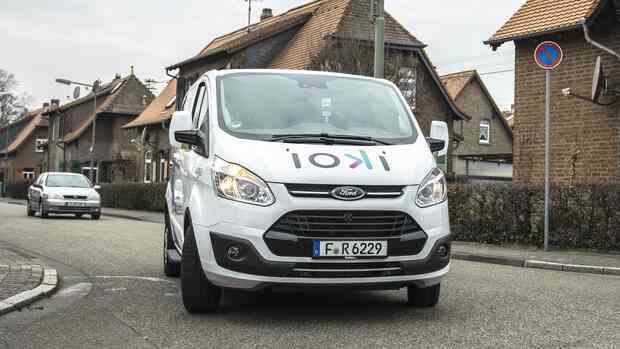Berlin From 2030 onwards, Deutsche Bahn wants to transport around 200 million travelers a year in its own on-demand buses, which means they only run “on request”. This was explained by Evelyn Palla, the board member responsible for DB regional traffic, on Tuesday evening in Berlin.
With the initiative, DB wants to make it easier to switch from private cars to local public transport, especially outside of the cities. “In In Germany, 55 million people live in rural areas, where there is currently far too little public transport,” said the board member, who was born in South Tyrol.
For these people, the aim is to “make regional public transport as flexible as your own car”. Passengers would order the shuttle buses to virtual stops that the app shows them. There would then no longer be any bus stop signs, nor would there be any fixed timetables for the buses to drive to them. The shuttles should also bring commuters to the train stations as a feeder to rail traffic.
So far, DB has only tested the service on a small scale – with moderate success. Since 2014, the subsidiary Clevershuttle has transported passengers on demand in selected cities such as Leipzig, Munich and Berlin, supported by the in-house IT platform “Ioki”.
Top jobs of the day
Find the best jobs now and
be notified by email.
However, the railway stopped operating its own commercial operations at most locations at the end of 2021 because the operation did not pay off. Since then, the on-demand shuttle buses have only been operated on behalf of cities, districts or transport associations – a business model that became established in local rail transport years ago.
Algorithm creates carpools for on-demand buses
The model is currently being tested in 18 rural test areas under the new operating concept. An algorithm from the train app Ioki is supposed to automatically put together carpools and make the operation more economical.
>> Read also: Why buses and trains will be significantly more expensive from 2023
In Aschaffenburg, minibuses from Nissan, Mercedes and VW have been driving since February 2022, and travelers can order them up to ten minutes before they want to start their journey. Four shuttle buses are being tested in the Regensburg district on behalf of the district’s own transport company GFN.
The trip in the electric Mercedes Vito costs the usual tariff plus a surcharge of three euros per person and trip. In the Chiemgau, the electric shuttles have been heading for up to 600 virtual stops since May 2022. 60,000 passengers have already been transported there, reports DB board member Palla.
Another on-demand test operation will start in Meinerzhagen in Sauerland from March 2023, in which DB Regio will also be using the Group’s own buses for the first time.
Deutsche Bahn is testing autonomous buses in Meinerzhagen
Connected, reliable on-demand shuttle buses could better connect rural areas and build on existing technologies. But Deutsche Bahn also wants to test autonomous driving soon and is currently developing self-driving buses with the Israeli company Mobileye, a subsidiary of the American Intel group. “If driverless shuttle traffic prevails,” says Palla, “that would be a game changer.”
The DB board member for regional transport presented three new projects on Tuesday evening.
(Photo: Deutsche Bahn AG / Hans-Christian Plambeck)
From the end of this year, the first passengers are to travel with the 15 autonomous shuttles, which are going into test operation in Darmstadt and in the Offenbach district on behalf of the Rhein-Main transport association. Drivers should only intervene in emergencies.
The taxi trade protested
If the test phase is successful, the buses should then be able to do without a driver. “Autonomous driving should reach level 4,” announces Palla. In Germany, DB would be a technological pioneer with the model, which has so far only been approved by law on fixed routes and with remote monitoring. In addition, the self-steering vehicles should flow along at the usual speed in road traffic.
>> Read also: Automated driving will upgrade local transport – a guest commentary by BVG boss Eva Kreienkamp
Sharp criticism of the on-demand offers comes from the German taxi industry. The Federal Association of Taxi and Rental Cars fears that providers are planning to “build up parallel fleets with taxpayers’ money”. Association President Herwig Kollar says that this could threaten the existence of the taxi companies: “Fighting against such heavily subsidized traffic will overwhelm the companies.” On-demand traffic must remain a matter for the taxi industry.
DB Regional CEO Palla sees “no conflict” with the taxi industry, she said at the request of the Handelsblatt. After all, the shuttles didn’t stop at the apartment door, only at fixed stops.
The “idea train” concept is intended to improve the quality of stay on the railways
Those who arrive at the train station with or without a shuttle bus and continue their journey by train should also benefit from one of two other new initiatives. “Train of ideas” is what DB Regio boss Palla calls the plan to improve the quality of stay in the suburban trains.
One of them will go into operation in March on the route between Munich and Mühldorf. New interior concepts such as office cubicles for working on the train, “regulars’ tables” for commuter groups, armchairs for relaxing and separate children’s areas are being tested.
For use in large cities, on the other hand, Palla is planning the “Ideenzug City”. “We expect a significant increase in passenger numbers in metropolitan traffic,” says Palla. Accordingly, they want to create more space in the trains – for example with foldable seats and an occupancy indicator on the platform so that the passengers are better distributed over the length of the train when boarding. This could also make entry and exit faster. Palla hopes that this will also increase punctuality.
More: Shared taxi companies rely on a new strategy – but the risks remain high
